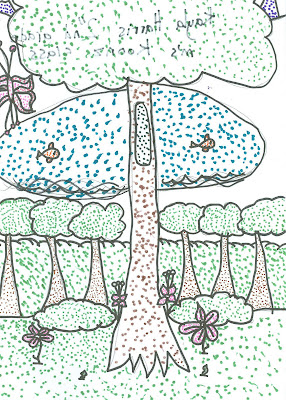Persian Illustration
Grade: 5th
# of sessions: 3-4
Art Resources: Shahnmeh of Baysunqur, My Persian Tale handout, teacher product and visual aide.
Art Materials: one 11”x14” sheet of white paper per student, pencils, erasers, texture mats, black permanent markers, rulers, markers, and crayons.
Objectives- Student will:
-create a drawing in the style of Persian Illuminated Manuscripts.
-create a drawing using pencils, markers, and crayons.
-learn about eastern architecture.
-create an architectural landscape.
-experiment with different textures
Relation to life/Why this is important: This lesson is a combination of architecture, illustration, drawing skills, and art history.
Interdisciplinary Connections: Social Studies, Math
Vocabulary: Persia, Illuminated Manuscripts, Architecture, Space, Texture
Procedure:
Day 1: Teacher will introduce Shahnmeh of Baysunqur. Teacher will discuss the vocabulary and major points of style in Persian Illuminated Manuscripts. Teacher will pass out Persian Style packet and discuss with class. Teacher will demonstrate how to set up the landscape and architecture using rulers. Student will brainstorm a story for at least two characters in their drawing. Student will draw on 11”x14” white paper his/her landscape, architecture and characters in Persian style.
Day 2: Student will review Shahnmeh of Baysunqur, vocabulary and teacher product/visual aide. Student will trace drawing in black permanent marker. Student will begin coloring with marker the details of the landscape, architecture, and characters.
Day 3: Student will review Shahnmeh of Baysunqur ,vocabulary and teacher product/visual aide. Student will finish coloring the details of his drawing. Student will add pattern and texture to the landscape and architecture using crayons and texture mats.
Day 4: Student will review Shahnmeh of Baysunqur ,vocabulary and teacher product/visual aide. Student will complete his drawing and write the story for his picture his My Persian Tale handout.
Tuesday, May 27, 2008
Monday, May 26, 2008
Graphic Organizers
I have started to really use graphic organizers for art history, critique, and procedures. This is a very helpful website filled with all sorts of graphic organizers: http://www.eduplace.com/graphicorganizer/index.html
Labels:
art,
art class,
art criticism,
art history,
graphic organizers
Sunday, May 25, 2008
Grant Writing Tips
Here are some helpful websites for grant writing:
http://www.ciwmb.ca.gov/Grants/Tips.htm
http://www.schoolgrants.org/tips.htm
http://www.afterschool.gov/xhtml/subject/58.html
http://www.leapfrogschoolhouse.com/do/findpage?pageKey=writing_tips
http://www.ciwmb.ca.gov/Grants/Tips.htm
http://www.schoolgrants.org/tips.htm
http://www.afterschool.gov/xhtml/subject/58.html
http://www.leapfrogschoolhouse.com/do/findpage?pageKey=writing_tips
Labels:
budget,
grant writing,
grant writing tips,
grants,
money
Saturday, May 24, 2008
A Challenging Group
One technique I am trying out in some of my more challenging groups is having the kids who are usually causing distractions to sit together with me. I did this in a very sneaky way by not telling them, just pulling up a chair and chatting with them. Now they are starting to be on my side and telling the rest of the kids to settle down. I enjoy this group more and stress less before I see them.
Friday, May 23, 2008
Kuna Molas
Every year I do Kuna Molas with my second graders. We use contsructiction paper and crayons to make ours, but here is another beautiful idea: http://www.saxarts.com/resources/lessonPlans/viewLessonPlan.jsp?lp=167
Labels:
art,
art education,
art history,
cultures,
kuna molas,
lesson plan
Thursday, May 15, 2008
Mother's Day Project
Wednesday, May 14, 2008
Saturday, May 10, 2008
Art in Action
Check out this program that was created for Bay Area schools. http://www.artinaction.org/index.html There is no mandatory art programs in California and this is a non-profit organization that works with over 70 schools in San Francisco. There is also an art camp and need for counselors with an online job application.
Labels:
art,
art education,
art in action,
art organizations,
non profit
Friday, May 9, 2008
Tips for Drying Greenware
1. Direct a fan at the pieces overnite.
2. While running the kiln, place pieces you want to dry quicker on top of it.
3. Do not dry clay in the sun, it cracks.
2. While running the kiln, place pieces you want to dry quicker on top of it.
3. Do not dry clay in the sun, it cracks.
Thursday, May 8, 2008
Matisse and Picasso ThinkTacToe
THINKTACTOE: A CHOICE MENU
Directions to Students: Circle three choices vertically, diagonally, or horizontally and complete at your seat.
Use a circle map to share your knowledge of Picasso’s life, art, and inventions.
Fill in a bubble map using the six elements of art to critique Harmony in Red.
Complete a tree map that shows characteristics of the blue, rose, and cubist periods in Picasso’s art.
Write at least 5 sentences describing how you would feel if you were Henri Matisse and critics called you a wild beast for your paintings.
Read Drawing with Scissors by Keesia Johnson and Jane O’Connor with two partners.
Make a flow chart to summarize five events in Matisse’s life.
Use a bubble map to use the 6 elements of art to analyze Guernica.
Create a tree map to classify at least 6 works of art by Picasso as either blue, rose, or cubist period.
Pretend you are an art critic at the Fauve show and explain why Henri Matisse is a wild beast in at least 5 sentences.
Wednesday, May 7, 2008
Thursday, May 1, 2008
Seurat Lesson for 2nd Grade

This is a student's example of a project I did with second grade on Georges Seurat and Pointillism. We read Getting to Know the World's Greatest Artists Georges Seurat by Mike Venezia. To remember the name of the style "Pointillism" I asked the students to point their index finger in there air every time we said "Pointillism!" The students filled in abubble map with Georges Seurat's masteripiece Sunday Afternoon on the Island of La Grande Jatte in the center. In each of the 10 bubbles the student wrote a fact they learned about Seurat and his art. We shared our maps as a class for art history review.
Subscribe to:
Posts (Atom)






